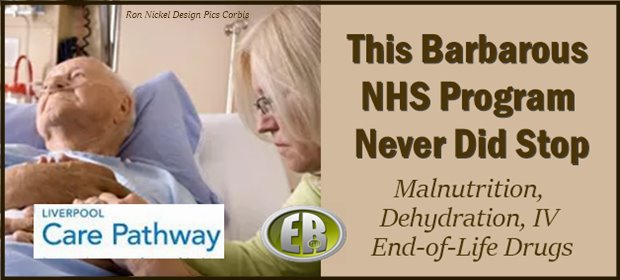
ER Editor: There are those voicing the suspicion that the current hullabaloo about Matt Hancock, former health minister, is meant to distract from revelations about the treatment (of lack thereof) and death pathways the elderly were put on around the time of Covid. Basically, the Liverpool Care Pathway (an utter misnomer), introduced in 2005, was supposedly abolished in 2014, only to be forcefully reactivated during Covid, apparently. Hence the finding of elderly corpses being emaciated and dehydrated, as well as injected with the lethal combination of midazolam and morphine.
However, it seems that the LCP was never really done away with, where the majority of the 600 cases currently under investigation occurred after the abolition and before Covid.
This article from The Conservative Woman today, by Rev Dr Patrick Pullicino, explains about the Liverpool Care Pathway. See Relatives must be empowered in end-of-life care decisions Of note:
AS A physician who has followed the issue of ‘end-of-life’ pathways closely over the last 15 years, the contents of the report ‘When End of Life Care Goes Wrong’, which Simon Caldwell (ER: see below for Caldwell’s article) wrote about in TCW on Sunday, are not a surprise. They are tangible proof of the terrible loss of patient autonomy which has occurred in the NHS in the management of the elderly and disabled patients. Six hundred families have come together as a clear statement that these end-of-life pathways are assailing families and leaving them bereaved and without closure. How did this come about?
Dame Cicely Saunders founded the modern hospice movement more than 50 years ago. She recognised that patients who were dying needed compassion and respect and that they should not be abandoned by their doctor but continue to receive the best medical care to the end. She was strongly against euthanasia and said that true palliative care ‘regards dying as a normal process and never hastens nor postpones death’.
The first clear departure from her principles was the Liverpool Care Pathway (LCP). The key component of the LCP was a mechanical syringe which continuously delivered three medications: morphine (pain killer), midazolam (sedative) and glycopyrrolate (reduces saliva). A nurse gradually increased the doses without need for a doctor’s input, based on a patient’s symptoms (‘anticipatory prescribing’). The LCP was successfully used on dying cancer patients so was extended to all patients who were deemed to be dying. It was quickly taken up into the NHS after 2005. An increasing public outcry against inappropriate deaths from the pathway caused the government to set up an inquiry which led to the Neuberger report, and the LCP was discontinued in 2013.
The use of the LCP had been facilitated by the Mental Capacity Act 2005, which made a fundamental change in the way that doctors look after patients. For those who lack the capacity to make their own health care decisions, the MCA established a ‘best interest’ group to take over end-of-life decisions. The revolutionary change in the MCA was that decisions are not taken by the consultant in charge of the patient but by a group of diverse carers including nurses and therapists, of which the doctor is only a member. Likewise, the input of the patient’s spouse or close family member was reduced to that of a member of the team. This poorly conceived legislation struck two heavy blows against medical patients, especially the elderly and disabled: the doctor’s responsibility for the patient at the medically and ethically most challenging time of their lives was taken away, and the view of the spouse or family member who knew the patient intimately was downgraded to the same as one of several carers who may just have met them.
This week’s report has made it clear that the flawed aspects of the LCP are still being used in hospitals.
********
When end-of-life ‘care’ is a death sentence
SIMON CALDWELL
Christine Pulfrey remembers her mother as ‘very fit’ and ‘in good form’ when she was admitted to a private hospital in Hull for a routine knee operation. Complications arose after surgery so the 86-year-old was transferred to the Hull Royal Infirmary where, according to her daughter, in February 2017 she was ‘deliberately deprived of hydration and food and was neglected’.
‘When she died she looked as if she had been starved, like people who were starved in the concentration camps,’ said Christine.
This anecdote is from one of 17 case studies included a report called ‘When End of Life Care Goes Wrong’, which will be published on Tuesday by the Lords and Commons Family and Child Protection Group in response to a growing number of complaints made by bereaved relatives to Voice for Justice UK, a campaign group.
All the studies, drawn from more than 600 cases (a total described by the group as only ‘the tip of the iceberg’), make deeply disturbing reading.
They include, for instance, the case of a 78-year-old man called John with non-terminal lung cancer. At the Countess of Chester Hospital he was injected with both morphine and midazolam, a lethal combination in a patient like him.
This jab, in the view of Sam Ahmedzai, Emeritus Professor of Palliative Medicine who offers medical analysis for each case study, was ‘directly responsible for the cessation of breathing’ some 30 seconds later. He concluded that the family ‘were made to witness what they could only interpret as an act of involuntary euthanasia’.
The family called in their lawyers, intent on bringing about the prosecution of medics who might have killed John by a combination of drugs they knew to be lethal. According to the report, their efforts were thwarted by medical documentation they say was fabricated but which was taken at face value by the police.
Another case concerned Laura Jane Booth, 21, who had learning difficulties and Crohn’s disease. She could communicate only through limited sign language, yet her family knew her as ‘kind and caring’ and someone who ‘loved life’.
Laura was admitted to the Royal Hallamshire Hospital in Sheffield for a routine eye operation and died there three weeks later. The NHS issued a death certificate attributing Laura’s demise to her conditions combined with pneumonia and respiratory failure from fluid on the lungs. Her family were convinced she was starved to death and fought for an inquest. They had to wait four and a half years for their day in court, but the coroner issued a new death certificate which listed untreated ‘malnutrition’ among the causes. Jamie Bogle, a barrister and co-author of the report, identifies this case as one of a number ‘where proceedings for alleged homicide may have been indicated’.
Fat chance of that. As a journalist who spent years researching and writing about the Liverpool Care Pathway, the end-of-life care protocol scrapped in 2014 as a ‘national disgrace’, I would consider it a minor miracle if the police took such complaints seriously. My debut novel, The Beast of Bethulia Park, https://amzn.eu/d/i9rllc1 published shortly before Christmas, was written partly with the purpose of demonstrating how unscrupulous doctors and nurses could use such ‘death pathways’ to kill elderly and ‘nuisance’ patients more or less with impunity, if they chose, or indeed, were encouraged to do so.
The evils about which I had heard so many families complain over the last decade are practised in the book by two villainous characters and other manifestations of the problem, which appear in this report, are there too: falsified death certificates, fabricated or omitted medical documents, police officers unwilling or unable to investigate allegations from families, a system which callously places obstacles in the way of aggrieved relatives seeking the truth, which short-circuits their complaints or takes years to resolve them and to scant satisfaction, and which treats the bereaved, the anxious and the heartbroken as contemptuously as criminals. Common mechanisms for killing are set out: contrived prognoses of death followed by the withdrawal of food and fluid and the simultaneous use of a sedating ‘chemical cosh’, or ruses like the deliberate use of contra-indicated drugs in patients susceptible to their lethal side effects. They appear in this report as well.
What is shocking and new about the report is that all but two of the case studies have occurred since the abolition of the LCP in 2014 following the review led by Baroness Neuberger the previous year. Eleven of the patient deaths described came after new guidelines were issued in 2015 by the National Institute for Health and Care Excellence, and four of them were within the last three years.
This would suggest that the problems that the demise of LCP was supposed to have remedied are continuing, that the protocol was damaged but far from dead, and that patients have been duped into believing they are safe.
The Rev Lynda Rose, a former barrister and the executive editor of the report, said the work of the parliamentary group showed ‘all too clearly that misdiagnoses and mis-assessments as to quality of life and proximity to dying are disturbingly common.
‘Excessive and inappropriate use of midazolam and morphine, rendering a patient comatose, coupled with the withdrawal of food and hydration, have combined to impose a death sentence on the elderly and vulnerable from which there is no right of appeal,’ she said. ‘For all our sakes we need to end the abuse now.’
The group is recommending a national inventory of local end of life care plans, policies and procedures being used in all healthcare settings; a national rapid response service to advise and support people who have a loved one experiencing poor quality end-of-life care; a fast track advice helpline for bereaved families; a national register of cases where end-of-life care has fallen below standards or breached guidelines; the urgent adoption of a uniform national system to capture patients’ preferences for end-of-life care, and further high quality research into social, medical and nursing aspects of end-of-life care.
However, Professor Patrick Pullicino, a recently retired consultant neurologist who was among the senior physicians to blow the whistle on LCP abuses more than a decade ago, believes that more must be done.
‘The report flags up shortcomings of the Care Quality Commission repeatedly,’ he said. ‘This is the body that is tasked with the safety of patients in NHS. The CQC must bear full responsibility for the continued use of lethal pathways.
‘They need to make dehydration a notifiable occurrence and sanction hospitals that dehydrate patients. The one body that could force a change and stop inappropriate deaths is doing nothing despite repeated complaints made to it.
‘The sick elderly necessarily take up a lot of hospital beds and therefore consume a lot of resources. Despite the increase in the elderly population, the number of hospital beds in the UK has dramatically fallen. It is impossible to avoid the connection with the widespread use of end-of-life pathways.’
Pullicino puts his finger on the nub of the problem. The real dangers of such pathways lie not inherently in the systems, the level of expertise of those who deploy them, or the extent of communication between families and medical professionals. They lie first and foremost in fallen human nature. Is it so really so difficult to accept that the ‘key workers’ of our glorious NHS are not always motivated by the best of intentions? Any system of care must not only be conceived, operated and regulated to the highest standards but be sufficiently robust and transparent to withstand the designs of those who would kill from pleasure or from conviction, and from those who would permit and encourage such killings for gain and for profit. Such people will always be around.
The NHS needs to be effectively policed. The law exists, after all, to protect the innocent and to punish the perpetrator. Yet this new report would suggest that in some areas of health care, it is barely present at all. That is not only a scandal, it’s a danger to all of us.
************
Source

••••
The Liberty Beacon Project is now expanding at a near exponential rate, and for this we are grateful and excited! But we must also be practical. For 7 years we have not asked for any donations, and have built this project with our own funds as we grew. We are now experiencing ever increasing growing pains due to the large number of websites and projects we represent. So we have just installed donation buttons on our websites and ask that you consider this when you visit them. Nothing is too small. We thank you for all your support and your considerations … (TLB)
••••
Comment Policy: As a privately owned web site, we reserve the right to remove comments that contain spam, advertising, vulgarity, threats of violence, racism, or personal/abusive attacks on other users. This also applies to trolling, the use of more than one alias, or just intentional mischief. Enforcement of this policy is at the discretion of this websites administrators. Repeat offenders may be blocked or permanently banned without prior warning.
••••
Disclaimer: TLB websites contain copyrighted material the use of which has not always been specifically authorized by the copyright owner. We are making such material available to our readers under the provisions of “fair use” in an effort to advance a better understanding of political, health, economic and social issues. The material on this site is distributed without profit to those who have expressed a prior interest in receiving it for research and educational purposes. If you wish to use copyrighted material for purposes other than “fair use” you must request permission from the copyright owner.
••••
Disclaimer: The information and opinions shared are for informational purposes only including, but not limited to, text, graphics, images and other material are not intended as medical advice or instruction. Nothing mentioned is intended to be a substitute for professional medical advice, diagnosis or treatment.





And btw, morphine is not a pain killer, it’s a plain killer.
It kills your blood’s ability to absorb oxygen ! What could possibly go wrong then ?
“End of Life Care” is and was always another name for euthanasia.
They can change the name many times, it won’t change the aim of this business.